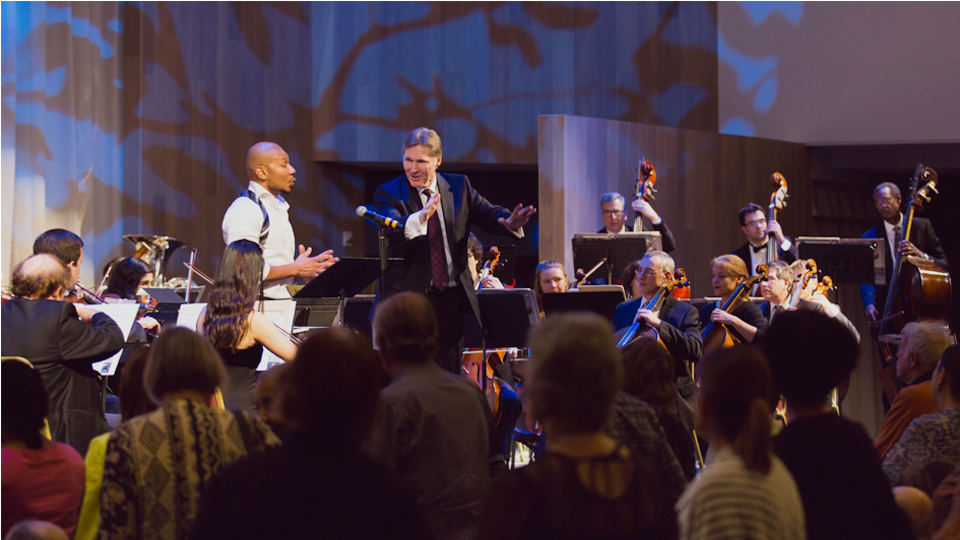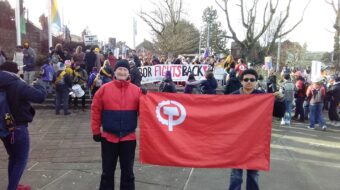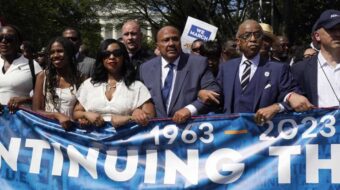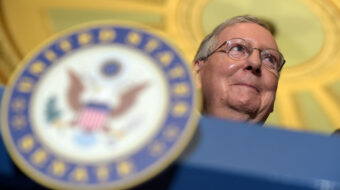
SANTA MONICA, Calif. — To kick off Martin Luther King weekend, the Santa Monica Symphony continued its now several-years-long tradition of presenting a concert free and open to the public—donations always welcome, of course—to honor the legacy of our nation’s greatest and most renowned spokesperson for civil and human rights, a Nobel Peace Prize winner and indefatigable opponent of the Vietnam War that was still raging at the time of his death almost 50 years ago, and a martyr for the labor movement when he was gunned down during the sanitation workers’ strike in Memphis.
The program featured four works, each with a special resonance for the occasion. Guido Lamell conducted at the modern and spacious SGI Auditorium.
Opening the afternoon, the percussion and brass blared out Aaron Copland’s brief but well-known Fanfare for the Common Man, written in 1942 in a populist idiom and inspired by then Vice President Henry Wallace, who proclaimed the arrival of “the century of the common man.” The U.S. was already well into the Second World War against Nazism and racial chauvinism. The post-war period in the United States, up to some point in the 1980s perhaps, represented a kind of fulfillment of the “common man” dream, when America, with its high taxes on wealth, became the first nation in the world to be truly considered a middle-class society and the envy of the world. Democracy was uneven, however: African-American servicemen returned home and once again faced Jim Crow, with its segregation, discrimination, voter suppression and lynchings. The current film Mudbound explores this period brilliantly.
Once McCarthyism and the new Red Scare emerged, however, Copland felt its brunt. His works were banned in American embassies and cultural centers abroad in view of his active participation in the broad United Front against fascism and the right wing in the 1930s and ’40s. In the mid-1930s his song “Into the Streets May First” was published in a radical songbook, and after the war he was a founding member of the American-Soviet Music Society. As McCarthyism faded, Copland’s reputation was restored: In his latter years he was widely recognized as “the dean of American composers.”
The centerpiece of the first half of the concert was a remarkable work by jazz composer Duke Ellington (1899-1974). Known for his estimated 3000 compositions, mostly short pieces that could fit onto one side of a 78 rpm record, he also created some larger works, such as the opera Queenie Pie and the extended symphonic piece Black, Brown and Beige. It premiered in Carnegie Hall in January 1943, but audiences were unprepared for a work of such proportions from someone they considered the master of the jazz miniature. After that season it was never again programmed in its entirety during the composer’s lifetime, though excerpts were recorded and performed occasionally. He played the first part, Black, at Lyndon Johnson’s White House in 1965.
The version heard on January 13, 2018, in Santa Monica, was one prepared by the eminent conductor, music historian and teacher Maurice Peress, in consultation with Ellington. In 1984 Peress became a professor at the Aaron Copland School of Music at Queens College, New York. Neither Guido Lamell, nor likely any of the orchestra, was aware that Peress had just died on December 31, so in a very real way, though unacknowledged, this concert was also a memorial to him.
In this version, the orchestral palette is expanded to include the full symphony orchestra complement of strings, oboes, bassoons, flutes, french horns and other instruments not normally part of the Big Band of Ellington’s era. At the same time, certain instruments, such as the saxophone or vibraphone, are not often part of the symphony orchestra unless specifically scored. The three separate sections, played without pause, portray “the whole African-American experience,” according to the useful program note: “Black, representing the days of slavery, including a work song, a spiritual and a section called “Light”; Brown, West Indian Dance, an Emancipation Celebration, and a Blues; and a final section, Beige, depicting the 1920s, ’30s and the Second World War….”
Ellington’s music is all-encompassing, both within and busting out of the Big Band container. The music flows from recognizable quotations, such as “Swing Low, Sweet Chariot,” into some Ellington tunes that sound familiar, into full orchestral statements. Packed with ideas, it is suffused with African-American idioms, alternating like quicksilver between “hot” and “cool” jazz sounds. A listener hears Harlem nights, stylish boulevardiers strolling to the Apollo Theatre, muted and buzzed brass instruments playing to suave, sultry dances. Naively, a concertgoer might think some of it sounds a little “Gershwin-y”—but this is in fact the source where Gershwin found his material and ultimately his own voice. Ellington himself did not like to refer to his music as “jazz.” He considered that too limiting. He said he wrote “American music.”
The Santa Monica Symphony is made up of mostly white performers, with small contingents of Asian-Americans, Latinos and Blacks. It’s a community-based ensemble, but every player is of professional level. Lamell, himself a long-term violinist in the Los Angeles Philharmonic, held the orchestra together throughout this on-the-surface unwieldy piece, but I am sure the required performance style must have been a challenge to many players unaccustomed to jazz tropes. It was no doubt a welcome introduction in some cases. It was a rare privilege to hear Black, Brown and Beige live.
Before the intermission, bass-baritone soloist Cedric Berry came to the stage to perform an aria by Giacomo Puccini, the first-act “Te Deum” scene from the opera Tosca. Why on a MLK concert? one might ask. Well, he had been engaged as the narrator for the concluding work in the second half, but Lamell wanted to give Berry a chance to display his singing voice, and this is the aria Berry chose.
It turned out to be most apt: Baron Scarpia, Chief of Police in Rome in 1800 during the Napoleonic Wars, is a torturing, murderous tyrant opposed to movements of liberty that are rising up all over the continent in the wake of the Haitian, American and French Revolutions. He is also trying to seduce the opera singer Tosca, promising that he will free her lover, the painter Cavaradossi, who favors the Napoleonic side. In terms that the #MeToo movement would instantly recognize, Tosca is about just that: the patriarchal manipulation and abuse of women—against the background of church music!—a timely theme remarked upon by the concert host, radio commentator Rich Capparela. Berry performed the aria to great acclaim. His bio states that he has “covered” a role in Tosca, which I presume means the role of Scarpia. I hope he gets the chance to perform it on stage soon. More on this singer can be viewed here.
Berry came back after intermission to join the orchestra in the difficult full orchestra-with-narrator work New Morning for the World, by American composer Joseph Schwantner (b. 1943). Subtitled “Daybreak of Freedom,” this symphony-length work from the year 1982 was introduced by the conductor in a short address to the audience as “the most complicated piece I have ever tried to conduct,” citing the many meter and tempo changes the composer calls for. He expressed the hope that the fine playing by the Santa Monica Symphony instrumentalists would “make him look good.” But such caveats were unnecessary: The work came across magnificently and was most appreciatively received.
It opens with drums, as does Copland’s Fanfare; and Schwantner also uses xylophone and bells prominently, as does the “Te Deum” church scene from Tosca, as if to symbolize both the freedom meaning in bells and the tolling for death and sacrifice. At critical moments the narrator recites some of the most beautiful and uplifting passages from the writings of Rev. Martin Luther King, Jr.—which is to say from perhaps America’s most eloquent rhetorician, whose words continue to inspire now five decades since his killing at age 39. Ironically, the Los Angeles Times on the morning of January 13 reported the death in prison of Edgar Ray Killen, the KKK leader convicted in the 1964 “Mississippi Burning” murders.
New Morning for the World is a significant modern entry into that catalogue of what might be called American “documentary music,” scores that incorporate passages from writings and speeches by people such as Thomas Jefferson, Abraham Lincoln, Franklin Delano Roosevelt, and documents such as the Bill of Rights. I’d never had the opportunity to hear Schwantner’s work live and am grateful for it.
The entire 27-minute piece, with the Eastman Philharmonia conducted by David Effron and Willie Stargell narrating, can be heard here. It’s worth a listen!
The concert concluded with Berry leading the audience in “We Shall Overcome,” accompanied by the orchestra. Many verses have been interpolated into this classic hymn remade into the anthem of the civil rights movement, but somehow this afternoon, inching toward the completion of the current racist president’s first year in office and looking forward to more protest, demonstrations and resistance, the words “We are not afraid” took on transcendent relevance. The chorus of hundreds of concertgoers sounded passionately committed, and some of the orchestra players could be seen singing along as well. In MLK’s words, “Men will,” indeed, “dare to live as brothers.”










